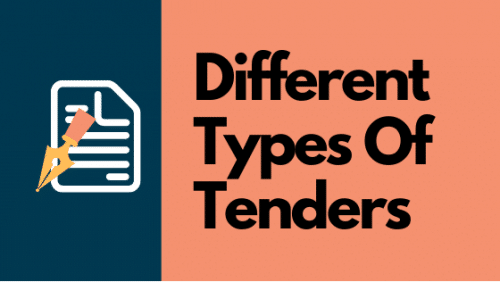
A successful bid management and tender process give a positive assessment approach that leads not exclusively to the appointment of best suppliers but also guarantees that the ongoing relationship between the client and the server would become beneficial. A completely organized and exceptionally effective bid and tender administration process improve the nature of the inventory network while reducing the expenses and complications.
A tender is a submission made by an imminent provider. It makes an offer for the stock of products/services. As the procurement process has become more complicated, tenders might be considered for a wide range of merchandise and enterprises and contractors may take on additional functions, such as planning and execution of the required project.
The 4 Important types of tenders are:
- Open tender
- Selective tender
- Negotiated tender
- Single-stage and two-stage tender
Open tender
Open tendering is the principle tendering procedures utilized by both the administration and the private sector. Open tendering allows anybody to present a tender to supply the merchandise or services required and offers an equivalent opportunity to any association to present a tender. This kind of tender is generally basic for the designing and construction industry.
Open tendering gives the best competition among suppliers and has the benefit of making open doors for new or developing suppliers to attempt to secure work. Not each one of the individuals who bid might be appropriate and eligible for the contract, some of the tenders take a long process to finalize the contract due to its major job requirement.
Selective tender
Selective tendering just allows suppliers to submit tenders by invitation. These suppliers are the individuals who are known by their reputation to be reasonable. Selective tendering gives customers more prominent confidence that their prerequisites will be fulfilled. It might be especially appropriate for expert or complex contracts, or contracts where there are just a couple of reasonable firms. However, it can prohibit small suppliers or those attempting to set up themselves in a new market.
Negotiated tender
Negotiated tenders are extensively utilized in the building and construction industry beginning from tendering till solving dispute resolutions. Negotiating with a single provider might be appropriate for exceptionally expert contracts, or for extending the current contract. Expenses are decreased and allow early contractor association since the contractor is a part of the venture group at every stage of the task, these outcomes in better correspondence and information flow.
Single-stage and two-stage tender
Single-stage tendering is utilized when all the information necessary to compute a sensible price is accessible when tendering commences. An invitation to tender is given to imminent suppliers, tenders are prepared and restored, a preferred tenderer is chosen, and following negotiations, they might be appointed.
Term tendering is usually used on significant projects of development and maintenance. The contractor has to cover a range of different buildings in various locations. It is usually limited to a fixed time scale, and if the client wants, he can extend it as per his requirements. The type of work is already specified, and the prices are fixed. The contractor will initially be offered the work to cover a number of different trades usually on the basis of prices contained in a schedule prepared by the client. Where the client provides the rates for the work, the contractors are given the option of quoting a percentage in adding or deducting from these rates depending upon their goal to lock the project. The contractor offering the best percentage to the client, will then be assigned the contract.
Two-stage tendering is utilized to allow the early appointment of a provider, preceding the finish of all the information required to empower them to offer a fixed price. In the primary stage, a constrained appointment is consented to allow work to start in two-stage, a fixed price is negotiated for the task.
Different types of tender incorporate sequential tendering, framework tendering and open procurement. Sequential tendering includes the readiness of tenders based on a typical or notional bill of amounts or timetable of works. Framework tendering allows the customer to welcome tenders from suppliers of merchandise and ventures to be done over a period on a call-off premise as and when required.
Final Thoughts
There are different types of tenders in the state as well as centre, many of the states have their tender names incorporated with the name of their respective state (for example, Maharashtra has the name of its eprocurement as Mahatenders). Similarly, there are many other states which process their tenders incorporating the name of their states.
Maharashtra, Uttar Pradesh, Bihar, Tamil Nadu are some of the states that release a significant amount of tenders, to know more about tenders, log on to BidAssist.com and get all the minute details regarding your required tender.
Author Bio:-
BidAssist helps SMEs discover latest tenders. Use our website or mobile apps to search anytime, anywhere. Get tender documents using our simple pricing plans.
